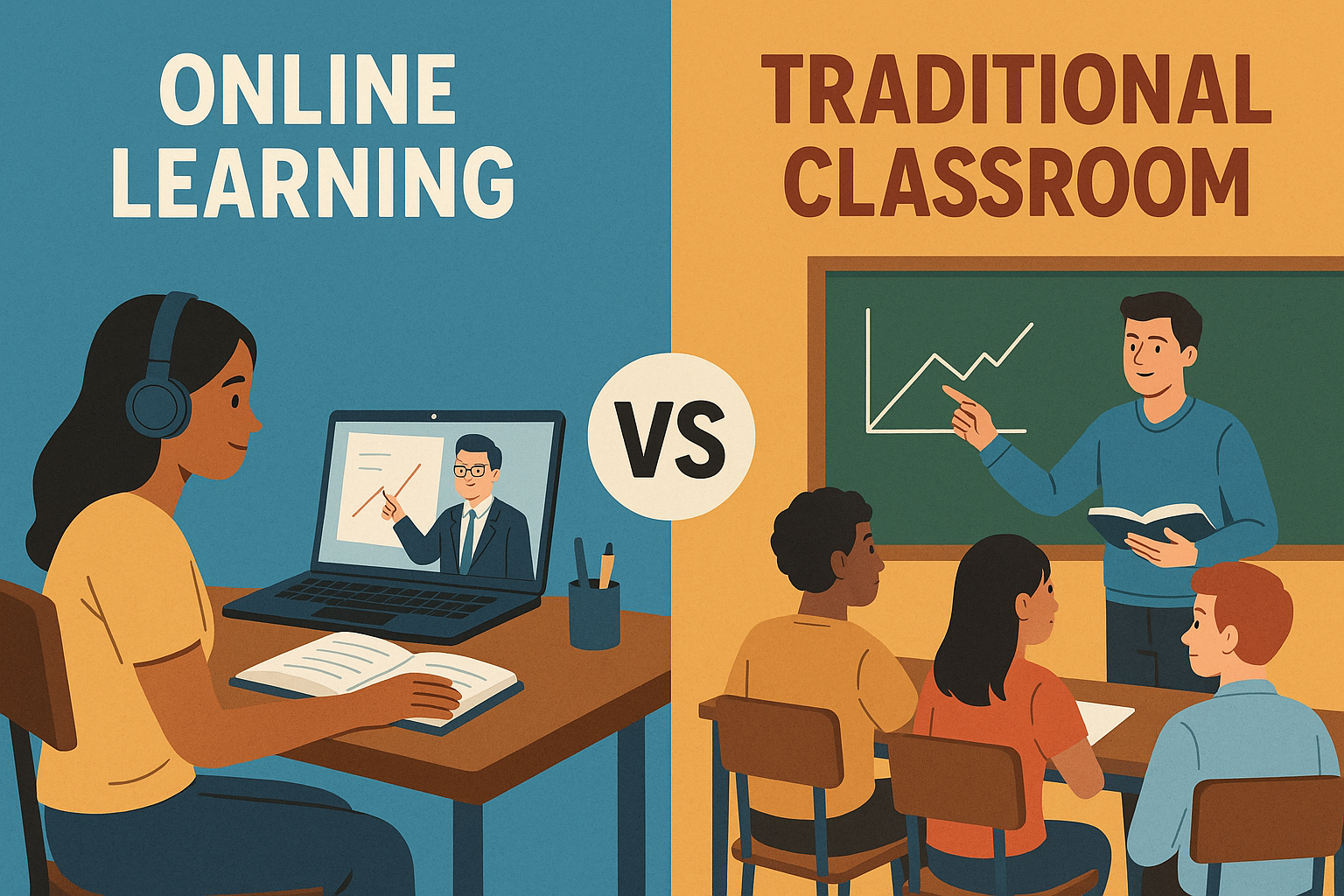
Introduction: The Education Debate of Our Time
The last decade has transformed how students learn. From chalkboards to screens, education has shifted drastically—especially after the COVID-19 pandemic. Online learning has gained massive popularity due to flexibility and global reach, while traditional classrooms remain trusted for discipline, face-to-face interaction, and structured environments.
But the central question remains: Which prepares students better—online learning or traditional classrooms? The answer requires a deep look into advantages, disadvantages, and future implications.
1. Online Learning: An Overview
Online learning (e-learning) uses digital platforms such as Zoom, Google Classroom, Coursera, or edtech apps to deliver lessons. It ranges from live classes to recorded lectures, self-paced modules, and AI-driven personalized learning.
Advantages of Online Learning
- Flexibility: Students can learn anytime, anywhere—ideal for working professionals or those with limited access to physical schools.
- Global Access: Learners can attend courses from top universities (Harvard, IITs, Oxford) without relocating.
- Cost-Effective: Saves on travel, accommodation, and often course fees.
- Personalized Pace: Students can pause, replay, or fast-forward lessons—ideal for different learning speeds.
- Tech Integration: Use of AI, VR, gamification, and simulations improves engagement.
Disadvantages of Online Learning
Digital Divide: Students from rural or low-income backgrounds often lack devices or internet access.
- Limited Social Interaction: Lack of face-to-face connection can reduce communication and teamwork skills.
- Motivation Issues: Requires strong self-discipline; easy to procrastinate.
- Screen Fatigue: Long screen hours affect eyesight, posture, and mental health.
- Practical Limitations: Hands-on subjects (lab sciences, medical training) are hard to replicate virtually.
2. Traditional Classrooms: An Overview
Traditional learning takes place in schools, colleges, and universities where students and teachers interact physically. It has been the backbone of education for centuries.
Advantages of Traditional Classrooms
- Structured Environment: Fixed schedules and routines build discipline.
- Face-to-Face Interaction: Improves social skills, teamwork, and teacher-student bonding.
- Instant Doubt-Clearing: Teachers can address confusion immediately.
- Hands-On Learning: Labs, workshops, and fieldwork give practical exposure.
- Less Screen Time: Reduces digital fatigue and promotes balanced lifestyles.
Disadvantages of Traditional Classrooms
- Limited Flexibility: Students must attend at fixed times—hard for working learners.
- Higher Costs: Tuition, commuting, and hostel expenses make it expensive.
- One-Size-Fits-All: Difficult to cater to different learning speeds in large classrooms.
- Geographical Barriers: Quality education may not be equally accessible in rural or remote areas.
- Overcrowded Classrooms: In many countries like India, teacher-student ratios are too high, reducing quality.
3. Academic Preparedness: Which Works Better?
- Online Learning: Better for theory-heavy subjects, lifelong learners, and professional upskilling. Encourages digital literacy, self-learning, and adaptability—skills highly valued in modern workplaces.
- Traditional Classrooms: Better for school-age students and practical learning. Builds collaboration, leadership, and discipline while offering real-time feedback.
Insight: For younger students (school level), traditional classrooms are more effective. For adults or advanced learners, online learning often works better.
4. Impact on Student Skills
- Online Learning Strengthens: Digital literacy, time management, global exposure, self-reliance.
- Traditional Classrooms Strengthen: Social skills, teamwork, leadership, empathy, and discipline.
Balanced View: Both prepare students differently—digital skills vs interpersonal skills. Ideally, students need both to succeed.
5. Mental Health and Well-being
- Online Learning Risks: Isolation, loneliness, and screen addiction.
- Traditional Classrooms Benefits: Peer connection, active lifestyle, reduced loneliness.
- Hybrid Models: Increasingly popular as they balance digital convenience with real-world interaction.
6. Career Readiness and Future Trends
- Employers value digital adaptability, which online learning enhances.
- However, soft skills like teamwork and communication (developed in traditional classrooms) remain crucial.
- Future education will likely be blended learning: part online (flexibility, global reach) + part offline (hands-on, social interaction).
7. Real-World Examples
- India’s Edtech Boom: Platforms like Byju’s, Unacademy, and Vedantu saw millions of users post-2020.
- Finnish Hybrid Schools: Many schools in Finland and Singapore are integrating digital modules with classroom activities.
- University Trends: Top global universities now offer MOOCs (Massive Open Online Courses) alongside on-campus degrees.
8. Which Is Better for Students?
There is no one-size-fits-all answer.
- Best for School Students: Traditional classrooms for structure and social learning.
- Best for College/Working Learners: Online learning for flexibility and career-oriented skills.
- Best for the Future: Hybrid/blended models combining the strengths of both.
Conclusion: Finding the Right Balance
The debate between online learning vs traditional classrooms isn’t about choosing one over the other—it’s about knowing which works best in which context.
- Online learning offers flexibility, accessibility, and digital skills.
- Traditional classrooms provide structure, community, and hands-on learning.
- The future of education lies in combining both—ensuring students are prepared not just academically, but also socially, emotionally, and professionally.
Final Student Tip: Adapt to both worlds. Use online platforms for learning flexibility but embrace offline spaces for teamwork and social growth.
Quick Comparison Table
| Flexibility | High | Low |
| Cost | Usually cheaper | Higher |
| Social Interaction | Low | High |
| Personalized Pace | Yes | Limited |
| Hands-On Experience | Limited | Strong |
| Global Exposure | High | Limited |
| Discipline & Routine | Requires self-control | Naturally enforced |



